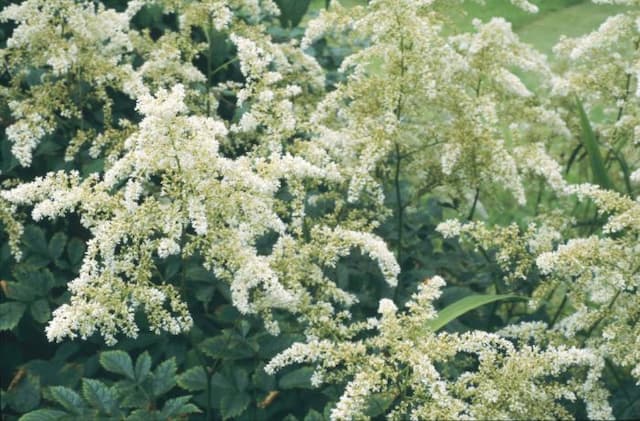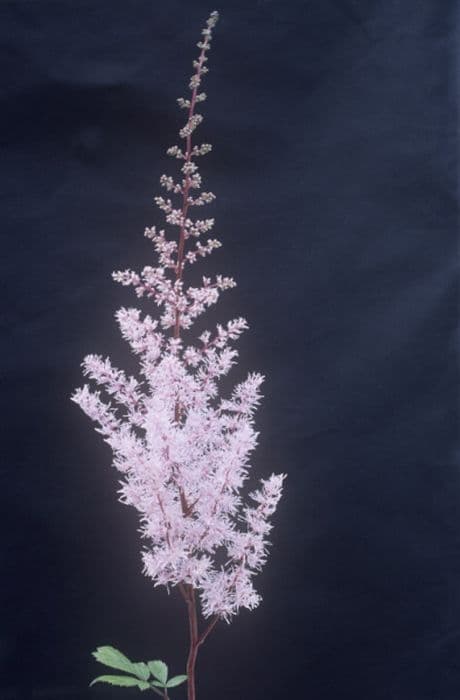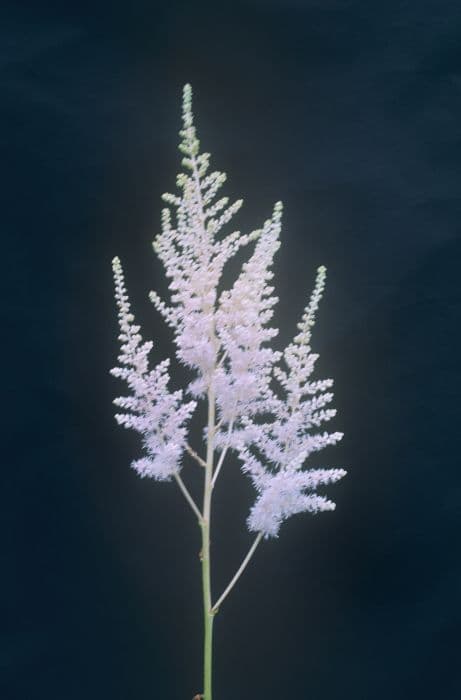False Spirea Astilbe 'Venus' (× arendsii)

ABOUT
Astilbe 'Venus' is a perennial plant known for its striking foliage and showy plumes of flowers. The leaves of this plant are intricately shaped, with many small, fern-like leaflets that come together to form a dense mound of greenery. The texture of the leaves can be described as both lush and delicate, with a somewhat glossy appearance that catches the light. The most eye-catching aspect of Astilbe 'Venus' is undoubtedly its blooms. The flowers appear on tall, erect stalks that rise gracefully above the foliage. These blooms are composed of numerous tiny, feathery flowers that are densely packed into narrow, pyramid-shaped clusters, which can seem almost fluffy. The color of the Astilbe 'Venus' flowers is a soft, romantic pink, with each tiny blossom contributing to the overall show of color. Overall, the Astilbe 'Venus' bears a look of elegance and lightness, with its airy plumes of flowers creating a contrast against the rich, deep green of its foliage. The flowering plumes can give the plants a striking presence in any garden setting, adding both vertical interest and a touch of whimsy. This plant typically blooms in the summer, offering a period of visual delight when many other plants are at their peak beauty. Whether planted in masses, as a border, or as a complement to other shade-loving perennials, Astilbe 'Venus' provides a delightful display with its charming flowers and attractive foliage.
About this plant
 Names
NamesFamily
Saxifragaceae.
Synonyms
False Spirea, False Goat's Beard, Feather Flower.
Common names
Astilbe × arendsii 'Venus'.
 Toxicity
ToxicityTo humans
False Spirea, commonly referred to as Astilbe 'Venus', is not known to be toxic to humans. Typically, ingestion of this plant does not cause any severe symptoms or poisoning. However, some individuals may have a sensitivity to the plant that could result in mild gastrointestinal discomfort or skin irritation. It is always advisable to handle plants with care and to wash hands after contact.
To pets
False Spirea, also known as Astilbe 'Venus', is considered non-toxic to pets such as dogs and cats. It is not known to cause any significant symptoms of poisoning if pets ingest parts of the plant. Nonetheless, it is generally recommended that pets do not eat ornamental plants as they could potentially cause mild stomach upset or an allergic reaction in some sensitive animals.
 Characteristics
CharacteristicsLife cycle
Perennials
Foliage type
Deciduous
Color of leaves
Green
Flower color
Pink
Height
2 feet (60 cm)
Spread
2 feet (60 cm)
Plant type
Herb
Hardiness zones
4
Native area
Asia Europe
Benefits
 General Benefits
General Benefits- Aesthetic Appeal: Adds vibrant color and texture to garden spaces with its showy, feather-like flower plumes.
- Ease of Care: Tolerant of a wide range of soil types, requiring minimal maintenance once established.
- Shade Tolerance: Thrives in partial to full shade, making it a suitable choice for darker areas of the garden.
- Attracts Wildlife: Blooms can attract butterflies and beneficial insects, enhancing biodiversity.
- Long Blooming Season: Provides a prolonged display of flowers, typically from late spring to late summer.
- Drought Resistance: Once established, can tolerate periods of drought, reducing the need for frequent watering.
- Soil Erosion Control: Dense foliage and root systems can help stabilize soil and prevent erosion.
- Non-Invasive: Unlike some ornamental plants, the False Spirea is not known to be invasive, making it an environmentally responsible choice.
 Medical Properties
Medical PropertiesThis plant is not used for medical purposes.
 Air-purifying Qualities
Air-purifying QualitiesThis plant is not specifically known for air purifying qualities.
 Other Uses
Other Uses- Photography Prop: The delicate and colorful plumes of the Astilbe make for a striking subject in botanical and macro photography, highlighting the textures and patterns of the plant.
- Artistic Inspiration: Artists can use Astilbe as inspiration for paintings, drawings, or textile designs, capturing the soft, feathery appearance of its blooms.
- Dried Flower Arrangements: When dried properly, Astilbe flowers maintain their shape and can add a touch of elegance to long-lasting floral displays.
- Literary Symbolism: Writers may incorporate Astilbe into their work as a symbol of patience and dedication due to its specific growing requirements.
- Education: Astilbe can be used in horticultural classes or workshops to teach about perennial plant care and shade gardening practices.
- Soundscaping: In gardens designed for the visually impaired, the rustling sound of Astilbe leaves can add an auditory element to the sensory experience.
- Crafting: The sturdy stems and unique texture of the Astilbe flowers make them a great material for creating homemade wreaths and other craft projects.
- Garden Theme Arrangements: Astilbe's variety of colors and textures can contribute to themed garden sections, such as fairy or cottage gardens.
- Ephemeral Art: Astilbe can be used to create temporary, eco-friendly art installations in outdoor settings, where the plants eventually decompose and leave no trace.
- Watercolor Painting: The intricate structure and soft colors of Astilbe blooms make them excellent subjects for watercolor artists exploring plant and flower motifs.
Interesting Facts
 Feng Shui
Feng ShuiThe plant Astilbe is not used in Feng Shui practice.
 Zodiac Sign Compitability
Zodiac Sign CompitabilityThe plant Astilbe is not used in astrology practice.
 Plant Symbolism
Plant Symbolism- Patient Love: Astilbe blooms in shady areas, patiently waiting for their time to shine, hence symbolising a love that is patient and understanding of timing.
- Dedication: With their hardy nature, astilbe represents dedication and perseverance in nurturing relationships, even under difficult conditions.
- Hope and Optimism: As a plant that thrives in difficult environments, it symbolizes hope and staying optimistic through challenging situations.
 Water
WaterFalse Spirea should be watered deeply to encourage root development, which typically means providing about an inch of water per week. During hot and dry periods, the watering frequency should increase to twice per week to maintain consistently moist soil as False Spirea thrives in damp conditions. Care should be taken not to waterlog the soil, as this can lead to root rot. Provide approximately 0.5 to 0.75 gallons of water per plant for each watering session, ensuring even distribution around the base of the plant.
 Light
LightFalse Spirea prefers partial shade to full shade conditions, thriving best in a spot that offers protection from the hot afternoon sun. The ideal location would provide morning light with dappled or filtered shade during the harshest parts of the day. These plants are perfect for shadowy areas in gardens where many other plants may struggle.
 Temperature
TemperatureFalse Spirea thrives in temperatures ranging from 60 to 75 degrees Fahrenheit but can tolerate a wider range from around 40 to 80 degrees Fahrenheit. It's resilient to cold and can generally withstand winter temperatures without significant damage, making it suitable for cooler climates. However, prolonged exposure to temperatures below freezing or above 80 degrees Fahrenheit can stress the plant.
 Pruning
PruningFalse Spirea should be pruned to remove spent flowers and encourage a second bloom, as well as to maintain its shape and promote airflow within the foliage. The best time for pruning is immediately after the first flowering period has ended. These plants can be pruned yearly, and dead or broken stems should be removed to keep the plant healthy.
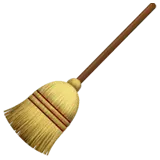 Cleaning
CleaningAs needed
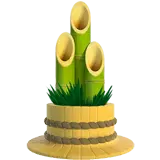 Soil
SoilThe False Spirea thrives best in a soil mix that is rich, moist, and well-draining, with plenty of organic matter such as compost or peat moss. The ideal pH for this plant ranges from 6.0 to 7.0 to maintain proper nutrient availability.
 Repotting
RepottingFalse Spirea rarely needs repotting; it's typically divided or transplanted outdoors rather than repotted. Divisions can be done every 3-4 years to maintain vigor.
 Humidity & Misting
Humidity & MistingFalse Spirea prefers a humid environment, consistent with its native woodland habitat, though it is quite adaptable and doesn't require specific humidity levels when grown outdoors.
 Suitable locations
Suitable locationsIndoor
Use rich, moist soil and bright, indirect light.
Outdoor
Plant in moist, fertile soil in partial shade.
Hardiness zone
4-8 USDA
 Life cycle
Life cycleThe life of an Astilbe 'Venus', commonly known as false spirea, begins with seed germination, typically in early to mid-spring when temperatures are cool and moisture is abundant. After germination, the seedling emerges and develops into a young plant with characteristic foliage; this vegetative stage involves the development of a strong root system and lush, feathery leaves. As the plant matures, usually by late spring or early summer, it enters the reproductive stage, producing tall, plume-like flower stalks with clusters of tiny, attractive pink flowers that attract pollinators to the garden. Following pollination, the flowers fade and seed pods form, which eventually dry and release seeds to propagate the next generation. In the late fall, the above-ground parts of the plant die back with the onset of colder temperatures, while the roots remain dormant through the winter. With the return of favorable conditions in spring, the plant re-emerges from its rootstock, completing the cycle and beginning a new growth season.
 Propogation
PropogationPropogation time
Spring-Early Summer
The Astilbe 'Venus', also known as False Goat's Beard, is typically propagated through division, which is the most popular method. The best time to propagate through division is in the early spring or late fall when the plant is not in active growth. To divide an Astilbe, carefully dig up the entire clump of the plant, making sure to keep a good amount of soil around the roots. Using a sharp garden spade or knife, split the clump into smaller sections, ensuring each section has at least two or three growth buds. Plant the divisions immediately at the same soil depth they were growing at previously, spacing them about 18 to 24 inches (45 to 60 centimeters) apart to allow enough room for growth. Water the newly planted divisions thoroughly to help establish them. This method stimulates new growth and helps maintain plant vigor, allowing gardeners to spread the beauty of Astilbe 'Venus' throughout their garden or to share with others.
